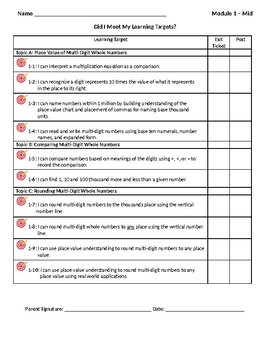4th Grade Eureka Math Self-Assessment and Goal Sheets (Mods 1-7)
- Word Document File
Description
Students use this form to check off the learning targets they met on the Exit Tickets each day, again on the Mid-Mod and End of Mod Assessments. The purpose would be to see growth over the course of the module. The back side of the form is separated into two sections: Pre-Mod and Post-Mod. In the pre-mod section, students set a SMART goal for themselves (i.e. On the Module 1 assessment, I will achieve an 80% or higher). They then write a specific action plan for how they will achieve their goal. My students keep these forms in their math folders until the end of the module when they take the summative assessment. Once they receive their scores, they mark off the learning targets they mastered at the beginning of the topic and then reflect on the back in the post-module section (Did you meet your goal for the end of mod assessment? If so, what do you attribute to your success? If not, what will you do differently to achieve your goals on the next mod?)





